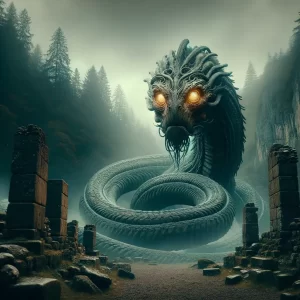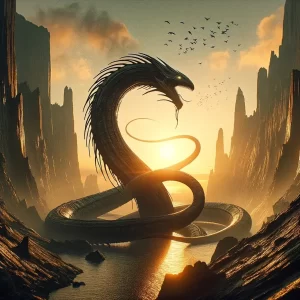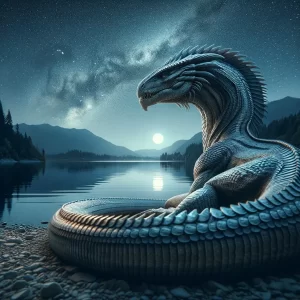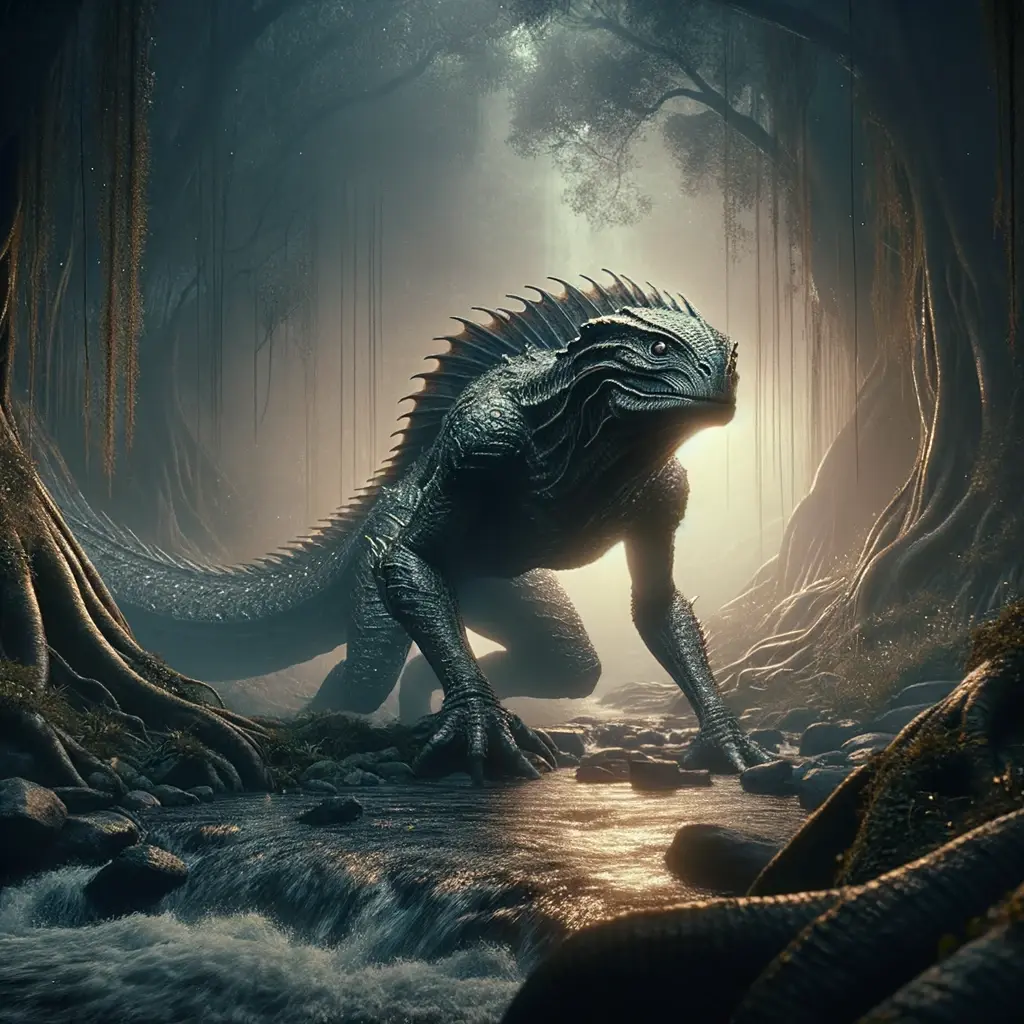The Oilliphéist is a Irish sea serpent-like monster in Irish mythology and folklore.
According to Irish oral tradition, these monsters were believed to inhabit many lakes and rivers in Ireland.
Many legends of saints and heroes fighting the Oilliphéist exist in Irish mythology.

Origins of the Oilliphéist
According to Irish oral tradition, the Oilliphéist was a dragon-like monster that cut the route of the Shannon River when it heard that St. Patrick had come to drive out its kind.
The creature was so powerful that it could cut through the land to form the river. The Oilliphéist was also said to be vast and strong, inhabiting a lake in Ireland.
The Oilliphéist is often associated with the Péist. The word “Oilliphéist” is derived from the Gaelic-Irish “oll” meaning great and “péist” meaning worm, fabulous beast, monster, or reptile.
The Péist is often depicted as a serpent or dragon-like creature, and it is said to have a venomous breath that could poison the land. In some legends, the Péist is a guardian of treasure or a symbol of fertility and rebirth.
The Oilliphéist is an important part of Irish myth and mythology, and it continues to be a popular subject of folklore and storytelling in Ireland.
The creature has been featured in many works of art and literature, including the Dictionary of Celtic Mythology.
The origins of the Oilliphéist are shrouded in mystery, but its enduring popularity is a testament to its enduring power and significance in Irish culture.
The Oilliphéist and Saint Patrick
Banishment of the Oilliphéist
According to the legend, the Oilliphéist cut the route of the Shannon River to prevent Saint Patrick from carrying out his plan.
The river was a vital transportation route for the people of Ireland, and the Oilliphéist’s actions caused widespread panic and chaos.
Saint Patrick, however, was not deterred. He confronted the Oilliphéist and banished it to Lough Dearg in Donegal, Ulster.
In some versions of the legend, the Oilliphéist was said to be the mother of demons, and its banishment by Saint Patrick was seen as a significant victory over evil.
Despite the banishment of the Oilliphéist, its legend lives on in Irish folklore. It is often depicted as a fearsome creature, capable of causing great destruction and chaos.
Its defeat by Saint Patrick is seen as a testament to the power of the saints and their ability to overcome even the most formidable of foes.

The Oilliphéist in Irish Folklore
Oilliphéist and the Drunken Piper
In Irish folklore, the Oilliphéist is a legendary creature that is often depicted as an Irish sea serpent-like monster.
One of the most famous legends involving the Oilliphéist is the story of the Drunken Piper.
According to the legend, a piper named Ó Ruairc or O’Rourke was playing his pipes by the banks of the River Shannon. The Oilliphéist, hearing the music, rose from the depths of the river and swallowed the piper whole.
Oilliphéist as a Sea Serpent
The Oilliphéist is often described as a sea serpent, similar to the Loch Ness Monster. It is believed to inhabit many lakes and rivers in Ireland, including the River Shannon, which is the longest river in Ireland.
In fact, one legend states that the Oilliphéist cut the route of the Shannon River when it heard that Saint Patrick had come to drive out its kind.
The Oilliphéist is also associated with other mythical creatures in Irish folklore, such as Muirdris, the sea monster, and Manannán mac Lir, the god of the sea.
Some believe that the Oilliphéist is related to the Salmon of Knowledge, which was said to possess all the knowledge of the world.
Despite its fearsome reputation, the Oilliphéist is also seen as a symbol of power and strength in Irish folklore.
It is often depicted as a dragon, similar to Ellen Trechend, or a great worm, and is believed to have the ability to swallow entire valleys or oceans.
In modern times, the Oilliphéist has become a popular subject in literature and art. It has even made its way into popular culture, with a bar in New York City named after the legendary creature.
The Oilliphéist and the River Shannon
One of the most famous stories about the Oilliphéist is how it created the River Shannon.
Creation of the River Shannon
According to legend, the Oilliphéist heard that Saint Patrick was coming to drive out its kind from Ireland. In an attempt to escape, the creature cut its way through the land, creating a path that eventually became the River Shannon.
The river is the longest in Ireland and is known for its beauty and importance to the country’s history.
This legend has been passed down through generations and has become an important part of Irish folklore.
Many people believe that the Oilliphéist was a real creature that once roamed the land, while others see it as a symbol of the power of nature and the importance of preserving the environment.
Despite the mythical nature of the Oilliphéist, there are many legends of saints and heroes fighting these monsters.
These stories often involve battles between good and evil, with the hero ultimately triumphing over the creature.

Frequently Asked Questions
What is the story behind the Oilliphéist in Irish mythology?
The Oilliphéist is a sea serpent-like monster in Irish mythology and folklore.
It is said to inhabit many lakes and rivers in Ireland. In one famous story, the Oilliphéist cuts the route of the River Shannon when it hears that Saint Patrick has come to drive out it and its kind.
What is the significance of the Oilliphéist in Irish folklore?
The Oilliphéist is an important figure in Irish folklore and mythology. It is believed to represent the power of nature and the unknown.
The Oilliphéist is also seen as a symbol of Ireland’s rich cultural heritage.
Are there any cultural references to the Oilliphéist in modern Ireland?
The Oilliphéist is still an important figure in modern Irish culture. It is often referenced in literature, music, and art.
The Oilliphéist is also used as a symbol of Ireland’s unique cultural identity.
What other creatures are associated with the Oilliphéist in Irish mythology?
The Oilliphéist is often associated with other creatures in Irish mythology. These include dragons, sea monsters, and other mythical beasts.
How is the Oilliphéist depicted in art and literature?
The Oilliphéist is often depicted as a fearsome sea serpent with a long, winding body.
It is also sometimes shown with wings or other dragon-like features. In literature, the Oilliphéist is often portrayed as a powerful and dangerous creature.
What is the origin of the legend of the Oilliphéist in Irish mythology?
The origin of the legend of the Oilliphéist is unclear. Some believe that it is based on sightings of real sea creatures, while others think that it is purely a mythological creation.
Regardless of its origins, the Oilliphéist remains an important figure in Irish folklore and mythology.
To learn more about Oilliphéist mythology, check out this video below:


